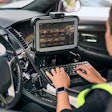Congress passed legislation in February that paved the way for a nationwide public safety broadband network by reallocating the 700 MHz D Block spectrum to public safety and providing $7 billion in grant money for the build out. The question now for officers around the country is, "What's next?"
There's no doubt that when this LTE (Long Term Evolution) system hits the streets for public safety, we'll see dramatic and immediate changes. For example, a sheriff might share a video of an escaping criminal and use predictive solutions to determine where he's headed, then send squad cars to that site to quickly apprehend him.
On a day-to-day basis, such innovation will save time and money for a police department, making searches and sweeps more efficient, and cutting back expensive overhead observation or pursuit by helicopters.
But there's really no Big Bang theory for the creation of a public safety LTE network. Unfortunately change won't take place all at once or across-the-board in all places. It also won't abandon other technologies that have proved their worth in certain areas.
Currently push-to-talk Land Mobile Radio (LMR) remains the standard for mission-critical voice communications. Even though it's decades old, LMR hasn't stood still. It has made the move from analog to digital, and since at least the middle of the last decade, it's been available as an IP network-based service. APCO P25 has also enabled much-improved interoperability between different LMR systems, provided enhanced functionality, and ensured competition through open standards.
One drawback of LTE at the moment is that it doesn't support voice. In the commercial arena, you can buy a 4G HTC Thunderbolt mobile phone, but it's a bolt without "volt"—that is, without Voice over LTE. A recent Government Accountability Office (GAO) report estimates that it could take 10 years or more before a public safety broadband network would be able to support mission-critical voice capabilities. In the meantime, VoIP remains a reliable alternative.
Choosing the right model for LTE will be critical for the network's success. Since we'll all live with the results for years—look at the longevity of LMR as proof—it's essential that we get the right technical models for LTE right at the start. The fallback position of using legacy, closed, proprietary approaches is still favored by a few. However, this is an antiquated notion for mission-critical communications.
The right technical model must be one that's in sync with technological development. That means a model based on the following principles: non-proprietary, open architecture, standards-based, customer-owned (with customer input on design), and above all, interoperable. In this case, the customer, of course, would be law enforcement agencies at the municipal, county, and state level.
The initial steps toward building out a nationwide network are now being taken; the FCC has appointed a technical advisory board for first-responder interoperability. We've got a long road ahead of us. As Tom Ridge, the first secretary of the Department of Homeland Security has publicly stated, it's going to take several years to build this network. The key will be maintaining a sense of urgency so another 10 years don't go by before it's fully functional.
Related:
Federal Stimulus Bill Establishes Public Safety Broadband Network














